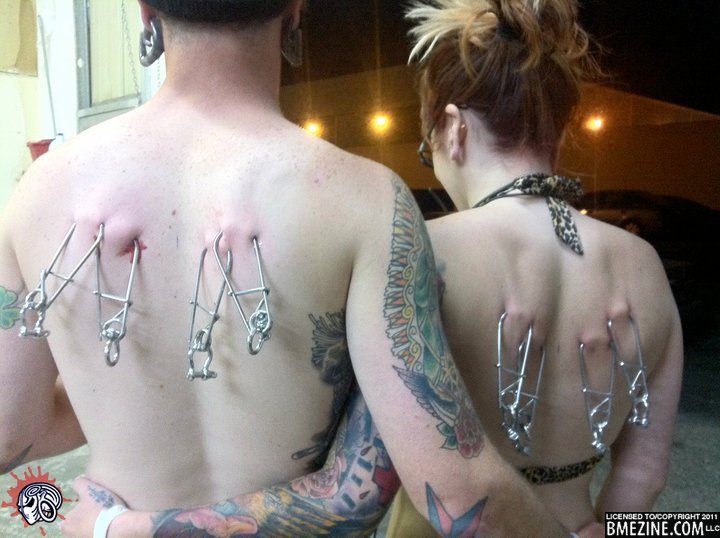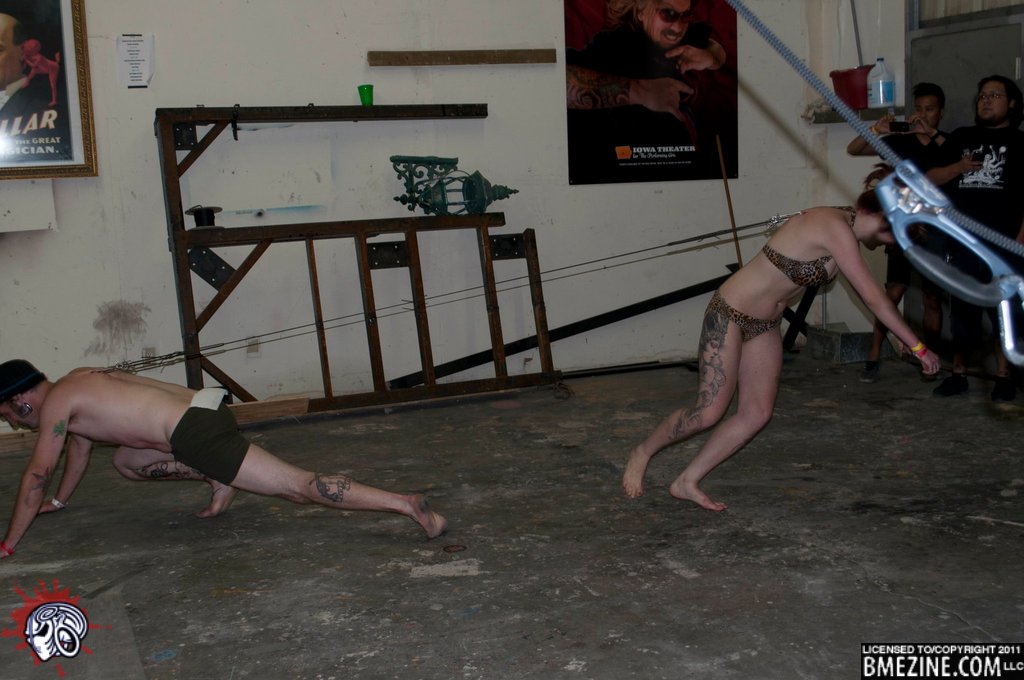You know, every time I type in the headline for the news roundup I hear The Daily Show theme in my head. Last week’s news went MIA when my internet decided to crap out on me for the weekend, however, this week everything is up and running, and there are some pretty interesting stories making the rounds.
First up is an interview with Baltimore‘s very own blue man, Mr. Bluecomma, Jim Hall.
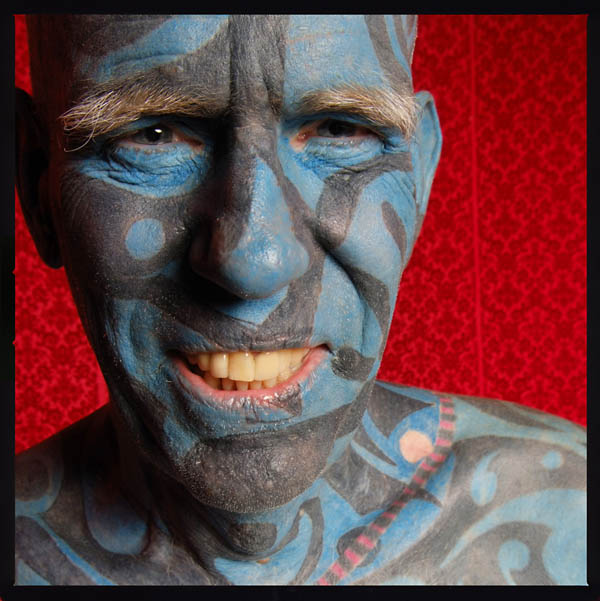
Hall, 67, a recent retiree from Baltimore City’s Planning Department, stands 6-foot-3 and his cut-off jeans and T-shirt reveal shaved-head-to-toe tattooed skin, inked blue and swarming with black swirls and crescents. Hall proudly explains that his tattoo is singular, one big skin-adorning tapestry, much as a Miro extravaganza is one painting with lots of free floating forms. A skin-scape. He is no less shocking on the streets of Baltimore than what the Romans encountered during their first failed invasion of the British Isles in the 1st century A.D. The Picts merely painted themselves blue for battle. Hall has inked himself blue for life.
Hall has lived in Federal Hill since 1972, but has kept his blue-skinned project a relative secret. In fact, Hall has been something of an urban hermit, avoiding publicity. But now Hall is interested in talking about his transformation into what he describes as “a new human species.” You see, Hall’s metamorphosis from a boxed-in city bureaucrat to a walking spectacle isn’t just skin deep.
What started out as a penis extension turned into three extra testicles, butt implants, chest implants, and more alterations to his penis, including a spike through it fastened by two rings the size of silver dollars. Not only did Hall have to endure the pain and the commitment of sticking with a body-modification plan 35 years in the making, also he estimates he has forked over more than $135,000. “Most people are born freaks, I turned myself into one,” Hall says, laughing. There’s another catchy saying he repeats innumerable times over the course of several interviews: “I’m glad you have to figure it out and not me.”
It’s a fantastic interview with a heavily modded gentleman who has a great outlook on life, and his personal changes.
More news to come, including yet another salvo fired in the war over Hermosa Beach’s tattoo studios.
We’ll head right into the next story which centers on Hermosa Beach and their continual battle against the town’s tattoo studios. This started early last year when the town banned any studios from operating. The studios filed a suit which made it all the way up to the 9th circuit where it was ruled that tattoos and tattoo studios are protected under the first amendment. Since then, the town has taken steps to marginalize the presence of the studios, while also paying the studio owners the judgement from the lawsuit. While the town has waved the white flag, some of the citizens are still clinging to hope that if they make enough noise, the studios will go away. Not likely.
The battle continued this week for Citizens United against Hermosa Beach, who are trying to force the city to create a more restrictive tattoo studio ordinance. The group brought a lawsuit against the city on April 14, claiming it did not take the proper steps to zone for incoming tattoo shops after the Ninth Circuit Court of Appeals ruled such businesses are protected under the First Amendment. Citizens United claims the city should have gone through its Planning Commission first, notified all residents near the proposed commercial zones and not adopted the new restrictions so swiftly.
Hany Fangary of Citizens United said the group plans to file the Second Amended Complaint that states the city did not properly publish notifications about public hearings on tattoo zoning and regulations before making them official. He said the Hermosa Beach City Council “intentionally moved to cut out input from residents” while going through the motions of creating its tattoo ordinances. Fangary said Citizens United would ultimately like Hermosa Beach to keep tattoo shops 100 feet from residences, 200 feet from schools and parks, close by 9 p.m. instead of 10 p.m. and not offer body piercing. This summer the Planning Commission suggested adding those additional restrictions, but the council denied them.
Mayor Howard Fishman voiced his displeasure for having to fight lawsuits that continually chew up municipal funds. “They have the right to pursue a legal action,” Fishman said of Citizens United. “However, I dislike lawsuits and spending taxpayer money to defend the city’s interest.”
At what point do you think they’ll finally give up? The studios are there to stay, and there’s only so much the courts will put up with before they shut down this group.
Another case of NIMBY is happening in LeRoy, NY where a pastor who operates a small church out of his living room was recently permitted to run a tattoo studio out of him home, but is encountering difficulties with having his home recognized as a church.
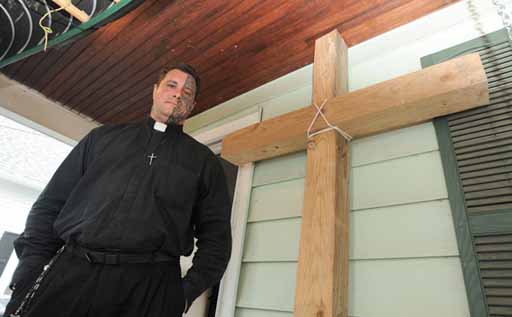
It’s difficult to overlook Eric Schultz in a small community. He is 7-feet tall, wears a clerical collar and has a tattoo that covers the left half of his face. Schultz, 40, also known as Father Eric, is founder of the months-old Church of Clarity in the Word of Christ, a small congregation based in his village home, 23 Lincoln Ave, where he also runs a body art parlor, Zoo Tattoo. Now, Schultz is seeking from the village a special use permit required for running a church in a residential neighborhood, but the request has encountered opposition from neighbors, several of whom spoke out at a public hearing this month.
Schultz and his wife of six months, Jean, 42, established the Christian church, which has about 15 members, in January. “God said to. God made it very clear to me,” Schultz said. The church has adopted teachings and theology from Catholicism and other Christian faiths. One of the texts it uses is the Catholic edition of the New American Bible. “We don’t subscribe to a denomination. That gets into a whole big area of semantics,” Schultz said.
His neighbors, however, are adamantly opposed to Schultz conducting services in his house. “There’s not one in favor. It would not help the community at all,” said Richard Schimley, of 20 Bradnell Ave., a block away from Lincoln. Schimley, a retired financial adviser, questioned Schultz’s credentials. “He’s a self-proclaimed priest, minister, pastor or whatever it is,” Schimley said. He believes one of the reasons Schultz has organized a church is to obtain tax-exempt status for his house. He suggested Schultz conduct his services by renting space in another church in the community.
Schultz said the concerns of his neighbors are based on incorrect assumptions. “They thought that we were a church that worshipped tattoos,” he said. “There was a lot of opposition to having a church in the house. “Really, we’re not doing anything.”
The Rev. Schultz emphasized tattooing is his trade but is separate from his church teachings. Body art is not required and the congregation doesn’t judge people about choices they’ve made in the past, he said. Schultz’s own facial art has no religious significance. He said it’s similar to tattoos the Maori, indigenous natives of New Zealand, put on their faces. He said he had it done years ago for its “shock value.” Schultz said he was “lost” and exploring various belief systems. The Bible doesn’t address the issue of tattoos and has less in it about body art than it does about haircuts, Schultz said.
Over in South Korea, tattooing is still fairly taboo. In fact only doctors are legally permitted to tattoo anyone. However, with the popularity of tattoos on the rise, a number of artists are coming out of hiding with the hope that attitudes will change.
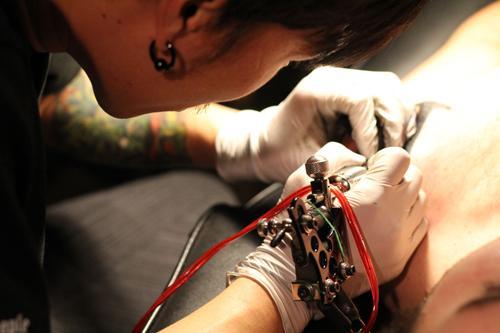
There are no signs indicating that a three-story building in the fashionable Hongdae area in western Seoul is home to a busy tattoo parlor. After walking up three flights of stairs to Tattoo People, one is greeted only by a large, black door, and, before walking through it, is required to change into slippers and make as little noise as possible as not to disturb the artists who may be inking skin inside. It’s not illegal to get inked in South Korea, but hundreds of tattoo shops operate underground and outside the purview of the law. Many of them are run by artists who openly advertise their services online and in magazines despite frequent government crackdowns.
In Korea, only licensed doctors can ink skin. Violators can be fined up to 20 million won ($18,939). This outdated medical law has caused much debate: If skin ink is an art, then how is it possible that only doctors can give tattoos? Many argue that doctors do not have the skill it takes to be tattoo artists. Historically, criminals were stigmatized with tattoos and cast out from society in Korea. Tattoos have often been associated with criminal behavior as well as membership in the Korean mafia, known as “kkangpae,” or “gangsters.” Aerok Kim is an influential tattoo promoter and founder of Korea’s most well-known tattoo shop called Tattoo Korea. He has had his parlor raided by police on separate accounts. “I called my lawyers who came in and asked the officers to leave,” he said. Most owners are not as lucky. Many tattoo artists cannot afford lawyers and live life on the run, setting up shop in a new location every couple of years to avoid run-ins with authorities.
Last year, the famous Korean singer Park Jae-bum, a former member of boy band 2pm, visited Tattoo Korea to request three tattoos: one behind each ear and one on his chest. “The next day, we received over 100 phone inquires and a lot of people were requesting the same tattoos,” Kim said. Tattoos have also been popularized through sports. Well-known Korean football player Ahn Jung-hwan flashed his tattoo to the world when he revealed it at a soccer match in 2003. When South Korea hosted the World Cup in 2002, it was evident that a few soccer players were sporting tattoos, helping to make it a more culturally acceptable trend.
To keep up with customer demand, Kim hopes to see changes in the laws restricting who can give tattoos and hopes that necessary changes will be made in order for industry standards to be raised. “Right now there are no sanitation standards set up in Korea and many unqualified young artists are working without a license because there isn’t any training available,” he said.
Moving on to the UK, police officers in Kent are being ordered to cover up any tattoos they may have.
The Police Federation, which represents officers, objected to the guidance and said tattoos could be an “ice-breaker” between the police and young people. Assistant Ch Con Allyn Thomas said staff were expected to look professional and smart while on duty. Kent Police Federation chairman Ian Pointon said the guidance highlighted “a generational gap”.
A statement issued by Kent Police said: “The policy at Kent Police is that some tattoos could potentially offend members of the public or colleagues, or could bring discredit to the police service. “Staff with tattoos that detract from displaying a professional image may be asked to cover them. A tattoo is deemed to be offensive if it is rude, lewd, crude, discriminatory, violent or intimidating.” Mr Thomas said: “As has always been the case at Kent Police, there is an expectation that officers and staff maintain a standard of appearance and dress considered professional, smart and approachable, whilst on duty.” Kent Police guidance on tattoos states: “Tattoos which may be considered to be offensive to any person, and/or are excessive – for example, covering a large area – will remain covered.”
Maybe the next generation of officers will finally be able to work without having to hide who they are.
Just a couple more stories to go, and then it’s off to the weekend. Philly.com did an interesting piece last week on the artists who donate their time to provide breast cancer survivors a replacement nipple.

Her wholly round 36Cs exposed, Paula Johnson watches Rose Marie Beauchemin mix pigment – first a little brown, then a little pink. Through the magic of permanent makeup, Beauchemin is about to tattoo nipples on Johnson’s reconstructed breasts. “It’s all about creating the illusion of protrusion,” Beauchemin said one recent Monday afternoon at her Mount Laurel office as she gradually shaded in Johnson’s areola and nipple area. After just three sessions, Johnson’s nipples look like the work of Mother Nature rather than Beauchemin’s deft use of an electronic magic marker. “This was the last step for me,” said Johnson, 55, a trace of relief in her voice. The grandmother from Cherry Hill endured a double mastectomy two years ago after she was diagnosed with early-stage breast cancer. Johnson’s mother died from the disease.
After all, Beauchemin points out, it’s the nipple that makes a breast a breast. This is why Beauchemin offers her tattooing services free to breast cancer survivors at her Beau Institute. “I don’t want women walking around without something that’s so important to them that takes me less than an hour to do,” said Beauchemin, who normally charges $300 to $800 per tattoo for women who have scarring from breast reductions or men who have had fat removed from their breasts.
 Beauchemin, with perfectly cut black hair and unsmudged eyeliner and lipstick, worked as a makeup artist for most of her career. Then in the early ’90s, a surgeon friend of hers suggested she learn the art of permanent makeup to help him with his trauma practice. He would reconstruct limbs lost in car and lawn-mower accidents, and she would use permanent makeup to cover up the scars.
Beauchemin, with perfectly cut black hair and unsmudged eyeliner and lipstick, worked as a makeup artist for most of her career. Then in the early ’90s, a surgeon friend of hers suggested she learn the art of permanent makeup to help him with his trauma practice. He would reconstruct limbs lost in car and lawn-mower accidents, and she would use permanent makeup to cover up the scars.
This next story was sent to me by Jeanne who used “Can you read French?” as the subject line. While my French has all but left me, I was still able to piece together enough to tell you this next story is pretty cool. About an hour north of Montreal lies the small town of Val Morin, which is home to a world renown Hindu temple and yoga center. It is at this place in the mountains of Quebec that people gather to celebrate Kavadi every year. Please excuse the very poor translation of the article, as I used an online translator which doesn’t differentiate between Quebec French and France French.
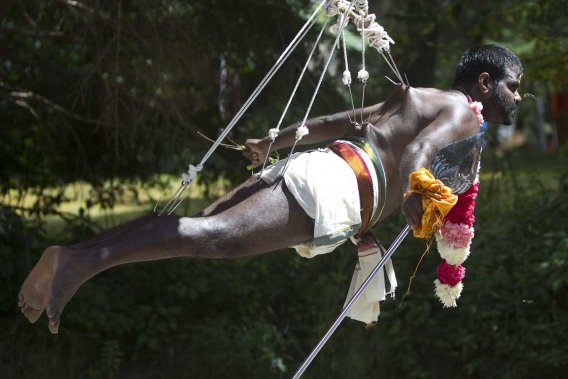
Smile at the lips, Mr. Tavakumar shows its bloody wounds to the movie camera. On his face, no sign of pain or of sunstroke. One feels it fresh as a rose. It nevertheless has just passed five complete hours suspended in the airs, with hooks in the back. Mr. Tavakumar was the one of the participants of Kaavadi, the Hindu festival that took place last Sunday to Valley morin. Each year since near of 20 years, the small city of the Laurentides welcomes thousands of Tamouls of origin sri-lankaise, come from as far as Toronto and Ottawa to pay homage to the God Muruga.
In 1962, the guru of the yoga Swami Vishnudevnanda had a heart blow for Valley morin in the Laurentides. Listening only his intuition, it there was founded a yoga center that is again today a high place of the meditation to Canada, indeed to the world. At first years 90, it let a temple construct to the same place, while dedicating it to the Hindu god Muruga. The place became a pilgrimage place for the Tamouls of North America, that there celebrate since the festival Kaavadi. The first years, it was necessary to agree with the resident of Valley morin. But today, the party more better is organized: the SQ checks the crowds and the volunteer ones of the center of yoga clean the town once the past parade. Swami Vishnudevnanda, that devoted a passion to the aviation, deceased in India in 1993, but his airplane is exposed to Valley morin close to the temple Subramanya/Ayyapa.
Again, that’s a horrible translation and I’d be more than willing to change it up if any of our Quebec readers could provide a better translation.
Today’s final story is from Esquire, where a professional Tumblrer (is that even a word?) interviews himself about why tattoos are stylish, and how to dress to impress. For the record, Rachel sent me this story and we both got a pretty good laugh at it.
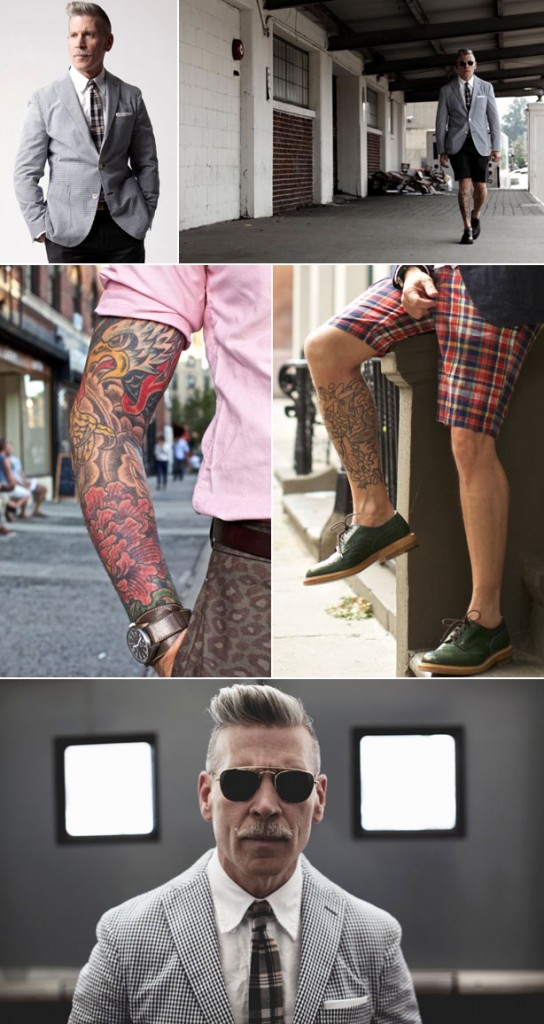
It started for me in 1993 or 1994. I was in Miami — and this is a bad, clichéd story: I had a pair of white Dries Van Noten sailor pants. So I thought I had to have a sailor tattoo: a heart with a dagger through it that said MOM on my left bicep.
My mom was not impressed, by the way.
What people say is true: The first one is a gateway drug. It will lead to another: “Oh, shit, I want something else.”
I was 39 when I did, essentially, a three-quarter sleeve on my left arm. It was very late in life, which is good: I can’t think of any decision I made at 19 that I’d be happy with at 39 or even now, at 51.
What will they look like at 80? You can’t think about it. Look, if I’m still standing at 80, that in and of itself will be a miracle. However I look will be just fine.
Yes, there are probably too many tattoos. But there are too many bad haircuts, too many bad shoe choices, too many bad jeans.
Because it’s so permanent, that’s a filter.
That’s so scary to me. You can tell when someone has them removed. It’s like plastic surgery. You’re not fooling anyone.
It goes on, but I could only stomach so much.
That’s it for this week everyone. Have a great weekend and remember to keep sending in those stories.














